Framing Scenarios of Binational Water Policy with a Tool to Visualize, Quantify and Valuate Changes in Ecosystem Services
Abstract
:1. Introduction
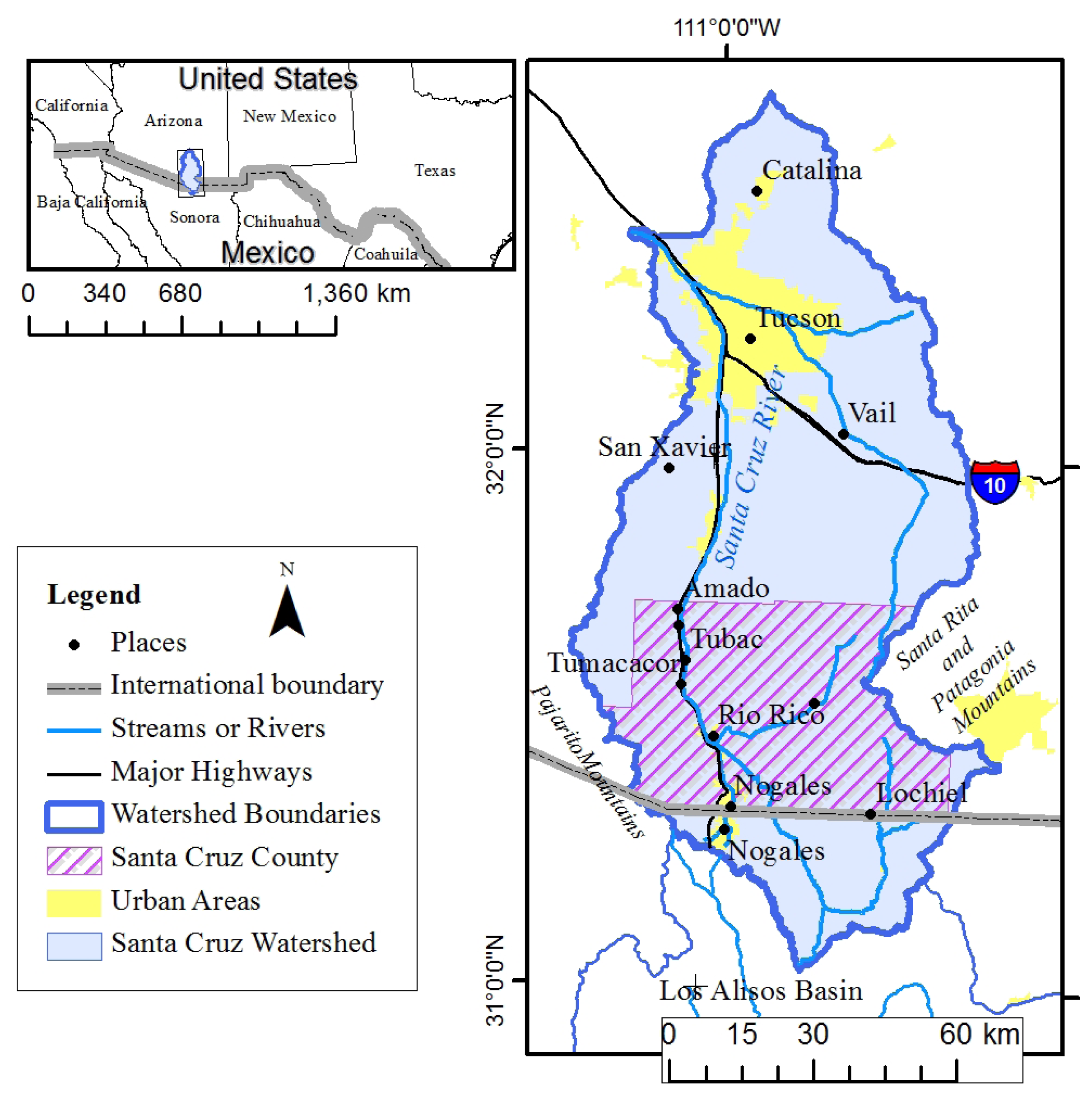

2. Materials and Methods
2.1. Binational Effluent Scenario Development
- Scenario 1: 100% or 15 MGD,
- Scenario 2: 83% or 12.5 MGD,
- Scenario 3: 67% or 10 MGD,
- Scenario 4: 50% or 7.5 MGD,
- Scenario 5: 33% or 5 MGD.
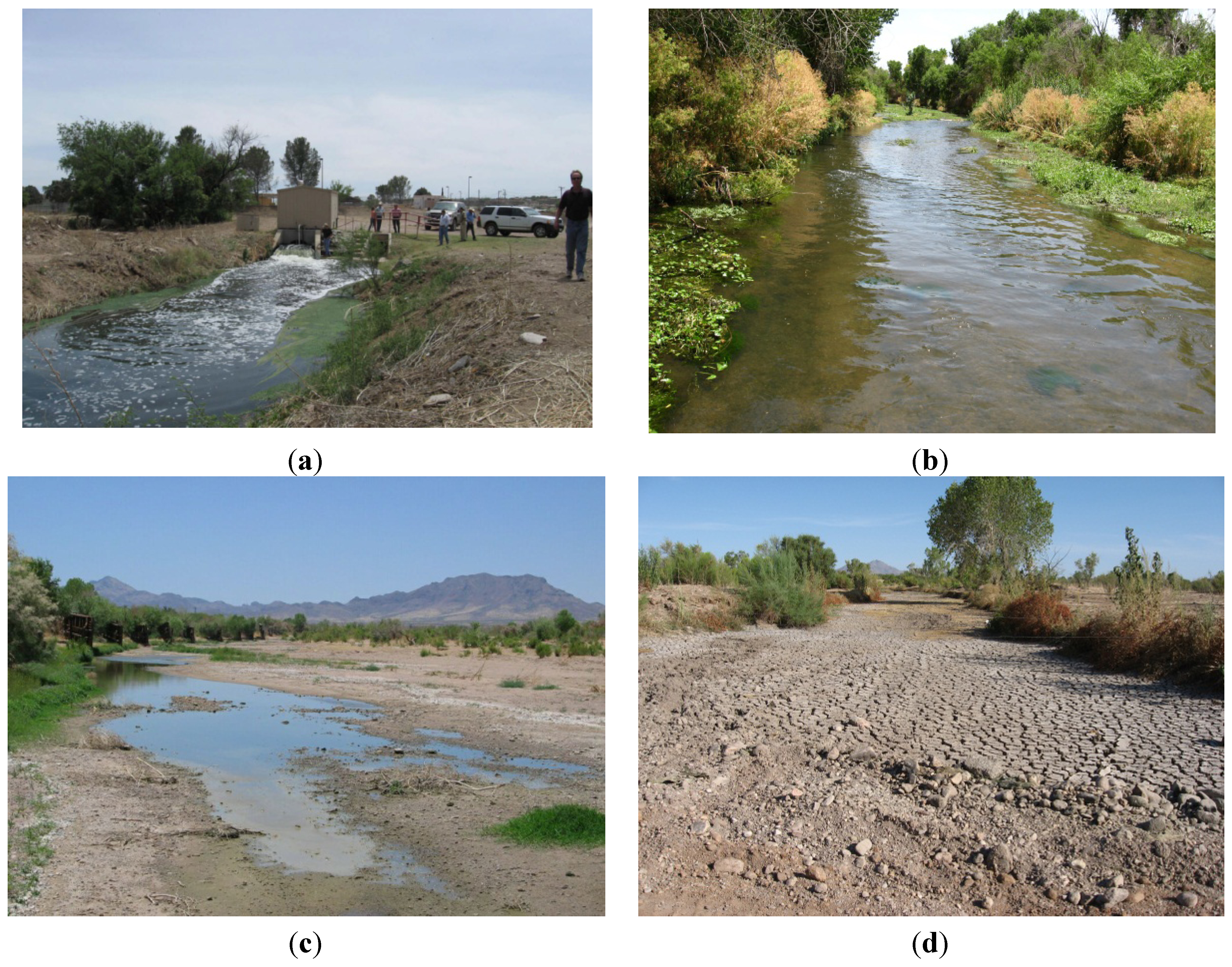
2.2. Santa Cruz Watershed Ecosystem Portfolio Model (SCWEPM)

2.2.1. Ecological-Value Submodel (EVM): Water, Vegetation and Wildlife Habitat
2.2.2. Market Land-Price Submodel (MLP)
2.2.3. Human Well-Being Submodel (HWB)
2.3. Benefits Transfer
3. Results
3.1. Scenarios
| Effluent Release Scenario | Perennial Surface Flow | Vegetation Habitat | Real-Estate Value | Vulnerable Communities Affected | Groundwater Recharge |
|---|---|---|---|---|---|
| Scenario 1: 100% | 18–25 mi. | N/A | 7,781 parcels with combined sales price of $30,370,153 baseline | N/A | Recharge estimates from the channel ~11,160 AFY baseline |
| Scenario 2: 83% | 16 mi. | IBA riparian zone impacted | 7,491 parcels with combined increase in sales price of $29,238,249 (difference/loss of  ) ) | Tubac impacted | Recharge estimates from the channel decrease by ~4% (  ) ) |
| Scenario 3: 67% | 11.5 mi. | IBA riparian zone and north of TUMA impacted | 6,684 parcels with combined increase in sales price of $26,088,434 (difference/loss of  ) ) | Tubac and Tumacacori impacted | Recharge estimates from the channel decrease by ~12% (  ) ) |
| Scenario 4: 50% | 10.7 mi. | IBA riparian zone and north of TUMA and TUMA impacted | 6,405 parcels with combined increase in sales price of $24,999,464 (difference/loss of  ) ) | Same communities at Tubac and Tumacacori impacted | Recharge estimates from the channel decrease by ~20% (  ) ) |
| Scenario 5: 33% | 6.3 mi. | Same IBA riparian zone and north of TUMA and TUMA impacted | 4,930 parcels with combined increase in sales price of $19,242,367 (difference/loss of  ) ) | Same communities at Tubac and Tumacacori impacted | Recharge estimates from the channel decrease by ~32% (  ) ) |
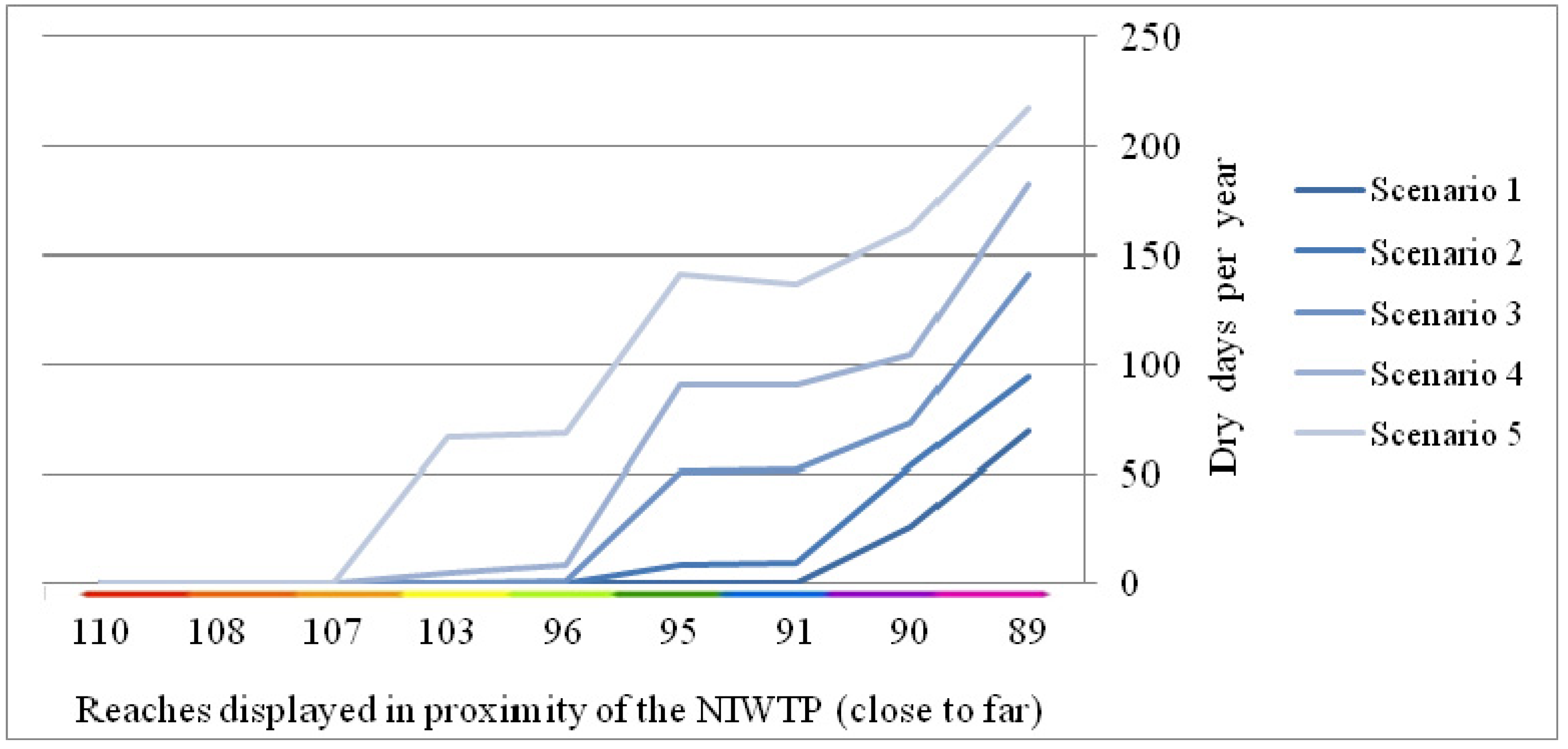

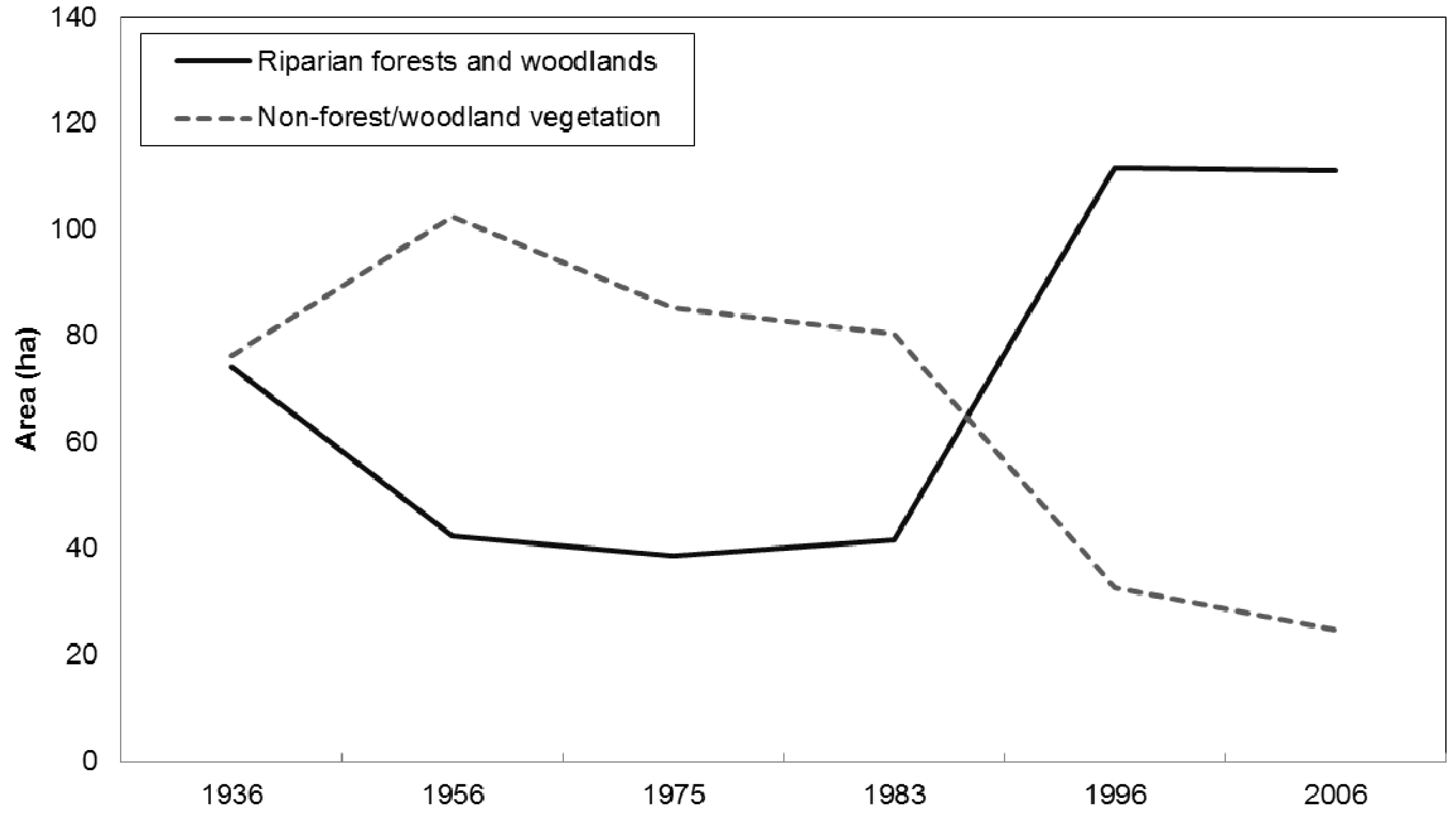
- In Scenario 1, where the current 15 MGD are being discharged at the NIWTP, perennial surface flow is expected to extend across 18–26 river miles, supporting riparian forest or woodland vegetation, habitat for 267 species and groundwater recharge estimates from the channel at approximately 11,160 AFY. According to the parcel map, 7781 privately owned parcels of real-estate exist within the 1.1 mile buffer of the river. This privately owned land calculation comprises 6331 ha of the 21,116 ha riparian buffer zone. The real-estate value of the riparian zone in RFW status is estimated to be $30.4 M.
- In Scenario 2, where 83% of current day discharge is released at the NIWTP (12.5 MGD), the perennial surface flow is reduced to approximately 16 river miles, impacting the IBA riparian zone on the Tucson Audubon-held conservation easement land and decreasing home values for up to 290 parcels of land (~461 ha). This results in a loss of up to $1.3 M in lost home value premiums, for the region. Highly vulnerable communities at Tubac are impacted by this loss. Recharge estimates from the channel decrease by approximately 4% (approximately 428 AFY).
- In Scenario 3, where 67% of current day discharge is released at the NIWTP (10 MGD), perennial surface flow is reduced to approximately 11.5 river miles, impacting the IBA riparian zone on the Tucson Audubon-held conservation easement land and areas north of Tumacácori. Home values for up to 1097 parcels of land (~1318 ha) will lose their riparian proximity value, including the highly vulnerable communities at Tubac and Tumacácori. This translates into real-estate value loss of up to $4.3 M for the region. Recharge estimates from the channel decrease by approximately 12% (approximately 1377 AFY) from the current day.
- In Scenario 4, where 50% of current day discharge is released at the NIWTP (7.5 MGD), the perennial surface flow is reduced to approximately 10.7 river miles, which impacts the IBA riparian zone on the Tucson Audubon-held conservation easement land, through all of Tumacácori National Historic Park (TUMA). Home values for up to 1376 parcels of land (1451 ha) will lose their riparian premiums, impacting the same highly vulnerable communities at Tubac and Tumacácori. The real-estate sales prices for the region, estimated to be lost by this scenario, are approximately $5.4 M. Recharge estimates from the channel decrease by approximately 20% (approximately 2186 AFY).
- Finally, in Scenario 5, where 33% of current day discharge is released at the NIWTP (5 MGD), perennial surface flow is reduced to approximately 6.3 river miles. The same IBA riparian zone on the Tucson Audubon-held conservation easement through all of TUMA is impacted. Home values for up to 2851 parcels of land (3056 ha) will lose their riparian premiums, equivalent to $11.1 M, impacting the same highly vulnerable communities at Tubac and Tumacácori. Recharge estimates from the channel decrease by approximately 32% (approximately 3564 AFY).
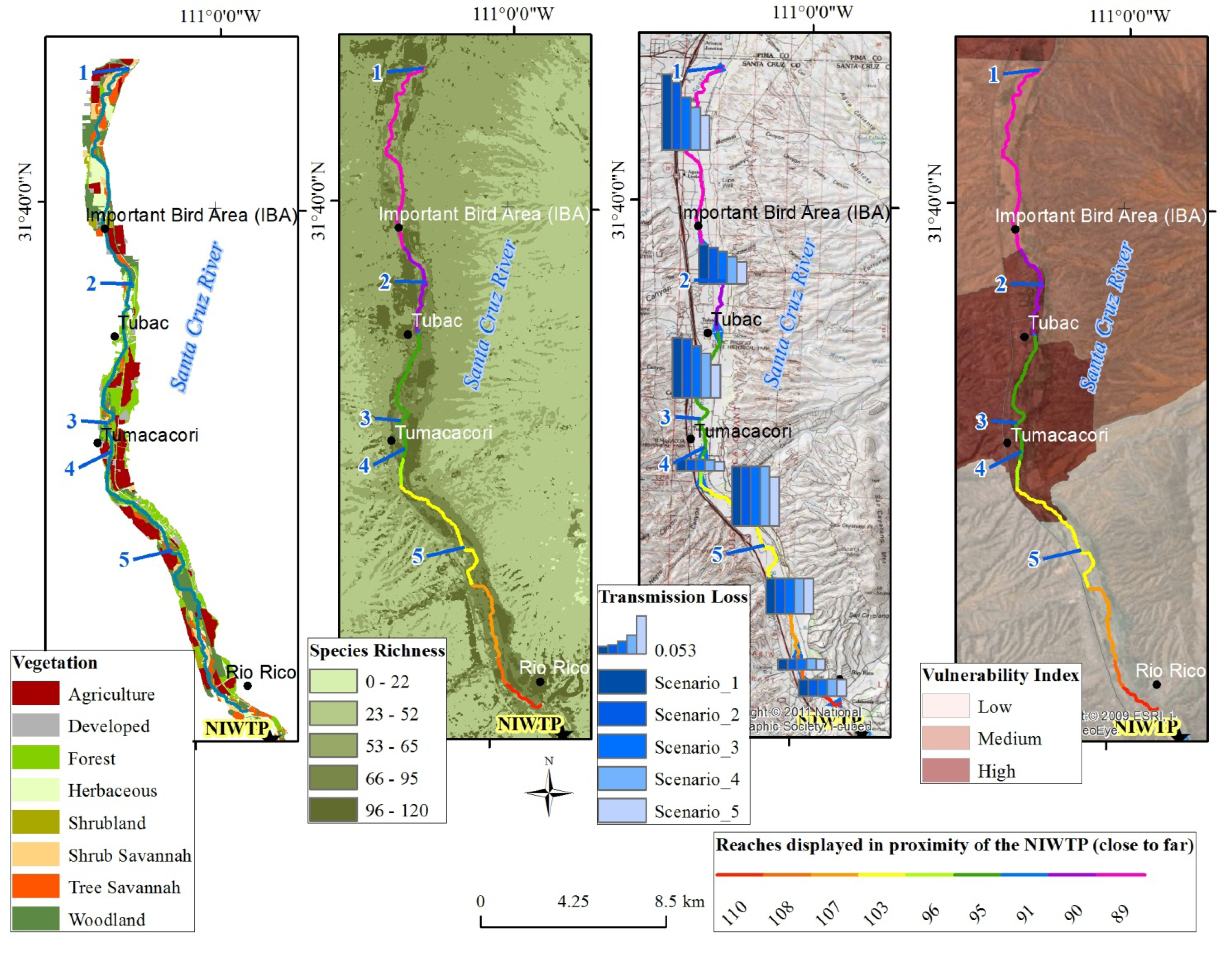
3.2. Benefit Transfer
3.2.1. Surface Water
| Scenario | Water discharged at the NIWTP outfall (MGD) | Dollar value of treated effluent at outfall/year * (million $) | Dollar value difference from current scenario of treated effluent at outfall/year *(million $) |
|---|---|---|---|
| Scenario 1: 100% | 15 | 2.42 | |
| Scenario 2: 83% | 12.5 | 2.02 | (0.40) |
| Scenario 3: 67% | 10 | 1.61 | (0.81) |
| Scenario 4: 50% | 7.5 | 1.21 | (1.21) |
| Scenario 5: 33% | 5 | 0.81 | (1.61) |
3.2.2. Ground Water
| Scenario | Water percolating to the SCAMA aquifers derived by SWAT SCWEPM (acre-ft/year) | Dollar value of water recharging the SCAMA aquifers/year * (million $) | Dollar value difference from current scenario to recharge SCAMA aquifers/year * (K $) |
|---|---|---|---|
| Scenario 1: 100% | 11,160 | 1.6 | |
| Scenario 2: 83% | 10,732 | 1.55 | (62) |
| Scenario 3: 67% | 9,783 | 1.4 | (198) |
| Scenario 4: 50% | 8,974 | 1.29 | (315) |
| Scenario 5: 33% | 7,596 | 1.1 | (513) |
3.3. Willingness to Pay
4. Discussion
5. Conclusions
Acknowledgments
References
- Brauman, K.A.; Daily, G.C.; Duarte, T.K.; Mooney, H.A. The nature and value of ecosystem services: An overview highlighting hydrologic services. Annu. Rev. Environ. Resour. 2007, 32, 67–98. [Google Scholar] [CrossRef]
- Varady, R.G.; Mack, M.D. Transboundary water resources and public health in the U.S.-Mexico border region. J. Environ. Health 1995, 57. No. 8. [Google Scholar]
- Norman, L.M.; Hirsch, D.D.; Ward, A.W. Proceedings of a USGS Workshop on Facing Tomorrow’s Challenges Along the U.S.-Mexico Border—Monitoring, Modeling, and Forecasting Change Within the Arizona-Sonora Transboundary Watersheds; U.S. Geological Survey Circular: Tucson, AZ, USA, 2008.
- Norman, L.M.; Villarreal, M.L.; Lara-Valencia, F.; Yuan, Y.; Nie, W.; Wilson, S.; Amaya, G.; Sleeter, R. Mapping socio-environmentally vulnerable populations access and exposure to ecosystem services at the U.S.–Mexico borderlands. Appl. Geogr. 2012, 34, 413–424. [Google Scholar] [CrossRef]
- Ojeda-Revah, L.; Brown, C. Environmental Services at the U.S.-Mexican Border. In Southwest Consortium for Environmental Research and Policy; The U.S.-Mexican Border Environment: Progress and Challenges for Sustainability; SCERP Monograph Series; San Diego State University Press: San Diego, CA, USA, 2012; pp. 145–185. [Google Scholar]
- Millennium Ecosystem Assessment, Ecosystems and Human Well-Being: Current State and Trends: Findings of the Condition and Trends Working Group, 1st ed.; Island Press: Washington, DC, USA, 2005.
- López-Hoffman, L.; Varady, R.G.; Flessa, K.W.; Balvanera, P. Ecosystem services across borders: A framework for transboundary conservation policy. Front. Ecol. Environ. 2009, 8, 84–91. [Google Scholar]
- Bark, R.H. Levelling the playing field—A case study of how non-market values can compete in policy debates over wastewater allocation in a semi-arid region. Policy Soc. 2011, 30, 311–321. [Google Scholar] [CrossRef]
- Norman, L.M.; Huth, H.; Levick, L.; Shea Burns, I.; Phillip Guertin, D.; Lara-Valencia, F.; Semmens, D. Flood hazard awareness and hydrologic modelling at Ambos Nogales, United States–Mexico border. J. Flood Risk Manag. 2010, 3, 151–165. [Google Scholar] [CrossRef]
- International Boundary and Water Commission (IBWC), Final Report of the Binational Nogales Wash United States/Mexico Groundwater Monitoring Program; International Boundary and Water Commission: El Paso, TX, USA, 2001.
- International Boundary and Water Commission (IBWC). Minute 276: Conveyance, Treatment and Disposal of Sewage from Nogales, Arizona and Nogales, Sonora Exceeding the Capacities Allotted to the United States and Mexico at the Nogales International Sewage Treatment Plant under Minute 227. 1998. Available online: http://www.ibwc.state.gov/Files/Minutes/Min276.pdf (accessed on 18 June 2013).
- International Boundary and Water Commission. Minutes between the United States and Mexican Sections of the IBWC. 2012. Available online: http://www.ibwc.state.gov/Treaties_Minutes/minutes.html (accessed on 18 June 2013).
- Erwin, G. Groundwater Flow Model of the Santa Cruz Active Management Area Microbasins International Boundary to Nogales International Wastewater Treatment Plant Santa Cruz County, Arizona; Arizona Department of Water Resources: Phoenix, AZ, USA, 2007. [Google Scholar]
- U.S. Environmental Protection Agency, Environmental Assessment for Water System Improvements; City of Nogales, Sonora, Mexico; U.S. Environmental Protection Agency: San Francisco, CA, USA, 1999.
- Vanderpool, T. Precarious Life; Sustained by Effluent, the Santa Cruz River Faces an Uncertain Future. Tucson Weekly. Tucson Weekly. 2012. Available online: http://www.tucsonweekly.com/tucson/precarious-life/Content?oid=3496904 (accessed on 8 April 2013).
- Hoerling, M.; Eischeid, J. Past peak water in the southwest. Southwest Hydrol. 2007, 6, 18–19. [Google Scholar]
- Dominguez, F.; Cañon, J.; Valdes, J. IPCC-AR4 climate simulations for the Southwestern U.S.: The importance of future ENSO projections. Clim. Change 2010, 99, 499–514. [Google Scholar] [CrossRef]
- Milly, P.; Betancourt, J.; Falkenmark, M.; Hirsch, R.M.; Kundzewicz, Z.W.; Lettenmaier, D.P.; Stouffer, R.J. Stationarity is dead: Whither water management? Science 2008, 318, 573–574. [Google Scholar]
- Kamp, D. Sonora sewage plant has ramifications for SC River. The Weekly Bulletin. 18 January 2011. Available online: http://www.nogalesinternational.com/the_bulletin/news/sonora-sewage-plant-has-ramifications-for-sc-river/article_2bb34952-f502-5e17-9382-707ddfd67d1f.html (accessed on 8 April 2013).
- Frisvold, G.; Osgood, D.E. Financing wastewater collection and treatment on the U.S.-Mexico border. Available online: http://opensiuc.lib.siu.edu/cgi/viewcontent.cgi?article=1146&context=jcwre (accessed on 18 June 2013).
- Johnson, R.; Haight, L.T.; Simpson, J.M. Endangered species vs. endangered habitats: A concept. Available online: http://www.rmrs.nau.edu/awa/ripthreatbib/johnson_etal_endspec.pdf (accessed on 18 June 2013).
- Skagen, S.K.; Melcher, C.P.; Howe, W.H.; Knopf, F.L. Comparative use of riparian corridors and oases by migrating birds in Southeast Arizona. Conserv. Biol. 1998, 12, 896–909. [Google Scholar] [CrossRef]
- Norman, L.; Tallent-Halsell, N.; Labiosa, W.; Weber, M.; McCoy, A.; Hirschboeck, K.; Callegary, J.; van Riper, C.; Gray, F. Developing an ecosystem services online decision support tool to assess the impacts of climate change and urban growth in the Santa Cruz Watershed; where we live, work, and play. Sustainability 2010, 2, 2044–2069. [Google Scholar]
- Costanza, R.; Folke, C. Valuing Ecosystem Services with Efficiency, Fairness, and Sustainability as Goals. In Nature’s Services: Societal Dependence on Natural Ecosystems; Island Press: Covelo, CA, USA, 1997; pp. 49–70. [Google Scholar]
- Gastelum-Ceballos, F.O. Planta de Tratamiento de Aguas Residuales Los Alisos. In Proceedings of Arizona-Mexico Commission’s (AMC) Environment Committee Meeting, Tucson, AZ, USA, 6 June 2012.
- Tosline, D. SCAMA/Nogales Water Storage Appraisal Study. In Proceedings of USIBWC Meeting, Nogales, AZ, USA, 22 May 2012; Available online: http://www.ibwc.state.gov/Files/CF_SEAZ_SCAMA_WSS_011212.pdf (accessed on 8 April 2013).
- Byrd, K.B.; Kreitler, J.R.; Labiosa, W.B. Tools and Methods for Evaluating and Refining Alternative Futures for Coastal Ecosystem Management—The Puget Sound Ecosystem Portfolio Model; Open-File Report 2011-1279; United States Geological Survey (USGS): Washington, DC, USA, 2011; p. 47. [Google Scholar]
- Labiosa, W.B.; Bernknopf, R.; Hearn, P.; Hogan, D.; Strong, D.; Pearlstine, L.; Mathie, A.M.; Wein, A.M.; Gillen, K.; Wachter, S. The South Florida Ecosystem Portfolio Model; a map-based multicriteria ecological, economic, and community land-use planning tool. In U.S. Geological Survey Scientific Investigations Report 2009-5181; U.S. Geological Survey: Washington, DC, USA, 2009; p. 41. [Google Scholar]
- McHarg, I.L. Design with Nature, 1st ed.; John Wiley & Sons: New York, NY, USA, 1991; p. 208. [Google Scholar]
- Arnold, J.G.; Srinivasan, R.; Muttiah, R.S.; Williams, J.R. Large area hydrologic modeling and assessment. Part I: Model development. Jawra J. Am. Water Resour. Assoc. 1998, 34, 73–89. [Google Scholar] [CrossRef]
- Neitsch, S.L.; Arnold, J.G.; Kiniry, J.R.; Williams, J.R. Soil and Water Assessment Tool: Theoretical Documentation; Version 2009; Texas Water Resources Institute: College Station, TX, USA, 2011. [Google Scholar]
- Niraula, R.; Norman, L.M.; Meixner, T.; Callegary, J. Multi-gauge Calibration for modeling the semi-arid Santa Cruz Watershed in Arizona-Mexico border area using SWAT. Air Soil Water Res. 2012, 5, 41–57. [Google Scholar]
- Stromberg, J.; Lite, S.; Beauchamp, V. Managing Stream Flow Regimes for Riparian Ecosystem Restoration. In Proceedings of Tamarisk Symposium, Grand Junction, CO, USA, 22–24 October 2003; Available online: http://www.coopext.colostate.edu/TRA/abstracts/2203Tamarisk/Stromberg.html (accessed on 8 April 2013).
- Villarreal, M.L.; Norman, L.M.; Boykin, K.G.; Wallace, C.S.A. Biodiversity losses and conservation trade-offs: Assessing future urban growth scenarios for a North American trade corridor. Int. J. Biodivers. Sci. Ecosyst. Serv. Manag. 2013, 9, 90–103. [Google Scholar]
- Villarreal, M.L.; Drake, S.; Marsh, S.E.; McCoy, A.L. The influence of wastewater subsidy, flood disturbance and neighbouring land use on current and historical patterns of riparian vegetation in a semi-arid watershed. River Res. Appl. 2012, 28, 1230–1245. [Google Scholar]
- Carruthers, J.I.; Mulligan, G.F. Environmental Valuation: Connecting Theory, Evidence, and Public Policy. In Proceedings of Annual Meeting of the Association of Collegiate Schools of Planning, Ft. Worth, TX, USA, 13–26 June 2006; Available online: http://www.huduser.org/publications/pdf/jic_gfm_rep_0501.pdf (accessed on 8 April 2013).
- Colby, B.G.; Wishart, S. Quantifying the influence of desert riparian areas on residential property values. Apprais. J. 2002, 70, 304–308. [Google Scholar]
- Bark-Hodgins, R.H.; Osgood, D.E.; Colby, B.G. Remotely Sensed Proxies for Environmental Amenities in Hedonic Analysis: What Does Green Mean. In Environmental Valuation: Interregional and Intraregional Perspectives; Ashgate Publishing, Ltd.: London, UK, 2006; pp. 191–209. [Google Scholar]
- Bark-Hodgins, R.; Colby, B.G. An economic assessment of the sonoran desert conservation plan. Nat. Resour. J. 2006, 46, 709. [Google Scholar]
- Bourne, K. Effect of the Santa Cruz River Riparian Corridor on Single Family Homes Using the Hedonic Pricing Method. Master Thesis, Department of Agricultural and Resource Economics, University of Arizona, Tucson, AZ, USA, May 2007. [Google Scholar]
- Bark, R.H.; Osgood, D.E.; Colby, B.G.; Katz, G.; Stromberg, J. Habitat preservation and restoration: Do homebuyers have preferences for quality habitat? Ecol. Econ. 2009, 68, 1465–1475. [Google Scholar]
- Bark, R.H.; Osgood, D.E.; Colby, B.G.; Halper, E.B. How do homebuyers value different types of green space? J. Agric. Resour. Econ. 2011, 36, 395–415. [Google Scholar]
- Arora, G.; Frisvold, G.B.; Norman, L.M. Hedonic Study at the Santa Cruz Watershed. In Proceedings of Santa Cruz River Researcher’s Day, Tucson, AZ, USA, 29 March 2012.
- Amaya, G.; Norman, L.M.; Frisvold, G.B. Measuring the Impacts of Natural Amenities and the US-Mexico Border, on Housing Values in the Santa Cruz Watershed, Using Spatially-Weighted Hedonic Modeling. In Proceedings of Santa Cruz River Researcher’s Day, Tucson, AZ, USA, 29 March 2011; Available online: http://sonoraninstitute.org/component/docman/doc_download/997-amaya-scrrd-2011-presentation.html (accessed on 8 April 2013).
- City-Data Santa Cruz County, Arizona Detailed Profile—Houses, Real Estate, Cost of Living, Wages, Work, Agriculture, Ancestries, and More. Available online: http://www.city-data.com/county/Santa_Cruz_County-AZ.html (accessed on 8 April 2013).
- Brouwer, R.; Spaninks, F.A. The validity of environmental benefits transfer: Further empirical testing. Environ. Resour. Econ. 1999, 14, 95–117. [Google Scholar] [CrossRef]
- Bruttell, N. Local golf courses increase prices after effluent rate hike Golfers prefer higher prices to yellow courses. Today’s News-Herald. 19 March 2011. Available online: http://www.havasunews.com/articles/2011/03/19/news/doc4d84291eaecaa062631554.txt (accessed on 31 May 2012).
- Lower Colorado River Authority Domestic Use. Available online: http://www.lcra.org/water/supply/contracts/domestic.html (accessed on 31 May 2012).
- Niraula, R.; Meixner, T.; Norman, L.M. Hydrological Modeling of a Semi-Arid Santa Cruz Basin. Santa Cruz River Researchers’ Day, Tucson, AZ, USA; 29 March 2012. Available online: http://www.friendsofsantacruzriver.org/userfiles/file/Researchers%27%20Day%202012/2012%20Researchers%27%20Day%20Proceedings.pdf (accessed on 8 April 2013).
- Wilson, M.A.; Carpenter, S.R. Economic valuation of freshwater ecosystem services in the United States: 1971–1997. Ecol. Appl. 1999, 9, 772–783. [Google Scholar]
- Frisvold, G.; Sprouse, T.W. Willingness to Pay for Binational Effluent. Water Sustainability Program; College of Agriculture and Life Sciences, The University of Arizona: Tucson, AZ, USA, 2009.
- Bureau of Reclamation, Lower Colorado Region. In Nogales Area Water Storage; U.S. Department of the Interior: Washington, DC, USA. Available online: http://www.usbr.gov/lc/phoenix/programs/progdescon.html (accessed on 8 April 2013).
- Tallis, H.; Kareiva, P.; Marvier, M.; Chang, A. An ecosystem services framework to support both practical conservation and economic development. Proc. Natl. Acad. Sci. USA 2008, 105, 9457–9464. [Google Scholar] [CrossRef]
- Muñoz-Piña, C.; Guevara, A.; Torres, J.M.; Braña, J. Paying for the hydrological services of Mexico’s forests: Analysis, negotiations and results. Ecol. Econ. 2008, 65, 725–736. [Google Scholar] [CrossRef]
- Nogales International New Study Shows SC River on the Rebound. Nogales International. 13 September 2011. Available online: http://www.nogalesinternational.com/news/new-study-shows-sc-river-on-the-rebound/article_c2adfdb4-de1c-11e0-9d8f-001cc4c002e0.html (accessed on 8 April 2013).
- U.S. Environmental Protection Agency. Watershed Priorities: Santa Cruz. Available online: http://www.epa.gov/region9/water/watershed/santacruz.html (accessed on 13 June 2012).
- International Boundary and Water Commission (IBWC). Conceptual Framework for U.S.-MX Studies for Future Recommendations Concerning the Riparian and Estuarine Ecology of the Limitrophe Section of the Colorado River and Its Associated Delta. Minute 306. 12 December 2000. Available online: http://www.ibwc.gov/Files/Minutes/Min306.pdf (accessed on 18 June 2013).
© 2013 by the authors; licensee MDPI, Basel, Switzerland. This article is an open access article distributed under the terms and conditions of the Creative Commons Attribution license (http://creativecommons.org/licenses/by/3.0/).
Share and Cite
Norman, L.M.; Villarreal, M.L.; Niraula, R.; Meixner, T.; Frisvold, G.; Labiosa, W. Framing Scenarios of Binational Water Policy with a Tool to Visualize, Quantify and Valuate Changes in Ecosystem Services. Water 2013, 5, 852-874. https://doi.org/10.3390/w5030852
Norman LM, Villarreal ML, Niraula R, Meixner T, Frisvold G, Labiosa W. Framing Scenarios of Binational Water Policy with a Tool to Visualize, Quantify and Valuate Changes in Ecosystem Services. Water. 2013; 5(3):852-874. https://doi.org/10.3390/w5030852
Chicago/Turabian StyleNorman, Laura M., Miguel L. Villarreal, Rewati Niraula, Thomas Meixner, George Frisvold, and William Labiosa. 2013. "Framing Scenarios of Binational Water Policy with a Tool to Visualize, Quantify and Valuate Changes in Ecosystem Services" Water 5, no. 3: 852-874. https://doi.org/10.3390/w5030852





